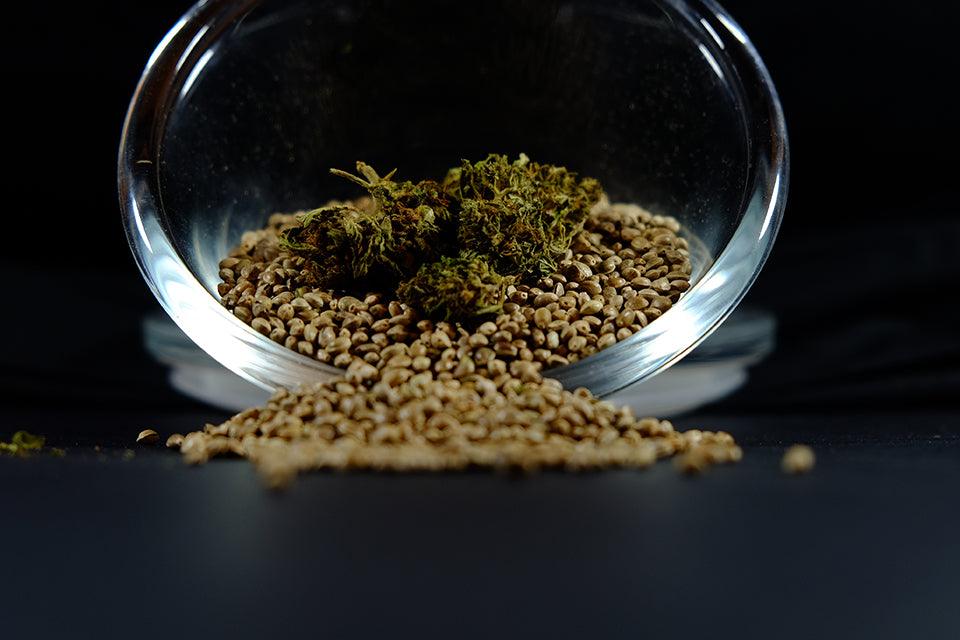Growing marijuana can be a risk if you don't know the tricks to maximize the chances of success of the operation. There are many tricks, pruning techniques and treatments that increase your chances of harvesting lots of quality grass.
One of the most popular tricks is to use feminized cannabis seeds . These are “genetically modified” seeds, in which the male chromosomes are 100% absent , thus ensuring that any plant grown from them flowers as a female and is capable of producing inflorescences for drying and smoking.
How were feminized seeds born?
The possibility of producing feminized seeds arrived at the beginning of the 21st century , when science discovered that Cannabis is subject to the possibility of sex change through chemical induction . This principle was discovered and applied in the production of watermelons: the feminized version of the seed did not produce fruit with seeds inside, unlike what happens with regular seed varieties.
To reproduce that female specimen, in the absence of male specimens, it will be necessary to replicate this genetics in the form of a seed - and not just in the form of a clone - by spraying chemical products on the flowering female to induce male flowers (and therefore seeds). Since the plant is female (XX chromosome), it produces a male-looking inflorescence (also with XX chromosome and not XY like a true male) which in turn produces pollen and reproduces on its own. Therefore with this pollination method all progeny seeds have female XX chromosomes since the female part transmits an X chromosome, as does the male.
How does cultivation change?
The production of feminized seeds was a revolution: for commercial growers this process reduced the risk of finding a male plant within the plantation . This is, in fact, one of the factors to be monitored most carefully when plants begin to grow. The males must be identified as soon as possible and removed from the rest of the cultivation, to prevent them from pollinating the female plants. If this were to happen, the female plant will begin to produce seeds , concentrating all its energies on them, which should instead be concentrated on the production of resin and flowers.
Of course, there are also risks to using feminized seeds. For example, if the female strain or clone selected as the main plant is potentially hermaphroditic, it can in practice disperse pollen into the air with the opposite result to that desired, i.e. flowers full of seeds. When creating a new feminized seed, before using it in the production of clones, you must test it all the way up to flowering and study its behavior, given that some strains respond better to the feminization procedure.
Over the last 18 years the demand for feminized seeds has exceeded that of classic seeds and breeders continue to create new strains through regular breeding, and then use the selected female to produce batches of female seeds. This could prove to be a risk: feminized seed should never be considered as an organic seed and its main application is to produce inflorescences and not to develop strains or follow cultivation programs.
How is feminized seed created?
There are many methods to create seeds with XX chromosomes, such as the use of hormones or chemical elements such as colcinic or gibberellic acid , but the most widespread and appreciable method is the one that uses the solution of silver thiosulphate or STS .How do we proceed?
The first step is to prepare the solution to treat the plant. To do this, two solutions will be used:
- solution A, composed of half a gram of silver nitrate diluted in 500 ml of distilled water;
- solution B, composed of 2.5 grams of thiosulphate solution (anhydrous) diluted in 500 ml of distilled water.
When mixing the two solutions you need to be very careful: you need to work in a ventilated environment and wear latex gloves and a mask, necessary to avoid inhaling the dust, which can be caustic.
Silver nitrate dissolves in about 15 seconds while sodium thioslofate takes about 30-45. The solution obtained will then be diluted 1:9 to make the compound usable . For example, by adding 100 ml of solution to 900 ml of distilled water you will obtain an excellent solution to spray directly on the plant. The two parts and the solution itself will then be kept in the fridge.
How is it applied?
The STS solution should be sprayed on the selected female plant . After application, the plant must then dry and then be exposed to light for 12 hours . This should be done approximately 3-4 weeks before the date on which the plants will be pollinated. Considering that the chosen plant will take approximately 3-4 weeks to produce a mature seed, a quality that takes 8 weeks to mature will have to be subjected to treatment a little early; while a plant that takes 6 weeks to mature will have to be subjected to the treatment afterwards so as not to finish before the seed is completely ripe.
After a few days after application you may notice a yellowing of the leaves . The effect should last a couple of weeks, after which the leaves will return to their original green. Growth will also stop after STS treatment, but will begin again in about 10 days. After 2 weeks the treated plant will begin to create male flower buds. The matured seeds will be feminized and it will take another 2-4 weeks before they can be used or sold.
What changes between feminized and autoflowering seeds?
Autoflowering strains are also genetically modified to flower in 2-4 weeks, regardless of light. In order to flower, normal feminized Indica and Sativa species must be exposed to light for 12 hours, so autoflowering seed plants can only be grown indoors. Autoflowering species are Indica or Sativa plants crossed with Ruderalis, a variety of cannabis that flowers automatically in a very short time (usually 2 to 4 weeks).
Autoflowering seeds are the right choice if you need to start several crops during the year , regardless of the season. The plants born from autoflowering seeds will be smaller than the same variety born from a classic seed, but on the other hand the flowering period will be shorter and the harvest will be more modest, but reliable .
Feminized strains grow over a longer period of time and, in optimal climate conditions, can reach a significant size . They are more delicate in terms of flowering, because they are exposed to the risk of pesticides and mold. Pruning can positively affect the growth of plants from feminized seeds, while it will not help autoflowering plants, which have a very short vegetative phase.
An additional advantage of feminized strains is that they can be cloned . The clone of a plant, i.e. a cutting that can be replanted, will not only maintain the genetic composition of the mother plant, but also its age. Taking a cutting from an autoflowering strain would mean that it would start flowering immediately, resulting in a very poor harvest. A feminized (or photoperiod) clone will still have enough time to develop during the vegetative state, allowing it to grow into a sizable plant before moving on to flowering.






